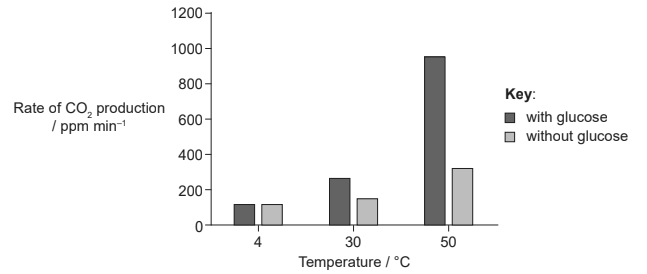IB Biology hL (HIGHER level)- 2024 – Practice Questions- All Topics
Topic 2.8 Cell respiration
Topic 2 Weightage : 10%
All Questions for Topic 2.8– ATP Production, Anaerobic Respiration, Aerobic Respiration, Yeast Fermentation, Respirometry, Energy Sources, Uses of ATP, Anaerobic vs Aerobic
Question
What is a difference between aerobic respiration and anaerobic respiration in yeast?
Anaerobic respiration requires enzymes, aerobic respiration does not.
Anaerobic respiration requires glucose, aerobic respiration does not.
Anaerobic respiration produces ethanol, aerobic respiration does not.
Anaerobic respiration does not produce oxygen, aerobic respiration does.
▶️Answer/Explanation
Ans: C
Question
Yeast cells, Saccharomyces cerevisiae, were incubated with and without glucose at three different temperatures for a period of four minutes, during which the rate of CO2 production was measured with a CO2 sensor.

What conclusion can be drawn from the results of this experiment?
Yeast uses lipids rather than glucose in respiration at low temperatures.
Addition of glucose has a greater impact on rates of cell respiration at lower temperatures.
Rates of cell respiration increase with temperature.
More glucose is produced at higher temperatures.
▶️Answer/Explanation
Ans: C
Yeast cells are able to respire both aerobically and anaerobically, depending on the availability of oxygen and glucose. When yeast cells respire anaerobically, they produce alcohol, heat and carbon dioxide as waste products. When they respire aerobically, they produce water and carbon dioxide as waste products.
The rate of cell respiration in yeast cells can be affected by different factors, such as temperature and glucose concentration. Generally, the higher the temperature and glucose concentration, the faster the rate of respiration, up to a certain point.
One way to measure the rate of respiration in yeast cells is to use a redox indicator, such as DCPIP or methylene blue, that changes color when it is reduced or oxidized. The indicator can be added to a suspension of yeast cells in a glucose solution and placed in a water bath at different temperatures. The indicator will change from blue to colorless as it is reduced by the hydrogens released from the substrate molecules during respiration. The faster the rate of respiration, the faster the color change will occur. The time taken for the color change can be recorded and compared across different temperatures and glucose concentrations.
According to some sources, the optimal temperature for yeast respiration is around 30°C to 40°C. Above this range, the yeast cells may die or become inactive due to denaturation of enzymes involved in respiration. Below this range, the yeast cells may become dormant or slow down their metabolic activity due to lack of kinetic energy.
Similarly, the optimal glucose concentration for yeast respiration may vary depending on the type and strain of yeast used. However, some sources suggest that a concentration of 1% to 10% glucose is suitable for yeast respiration. Above this range, the yeast cells may experience osmotic stress or inhibition of enzymes due to high sugar concentration. Below this range, the yeast cells may not have enough substrate to respire efficiently.
Therefore, if a yeast cell were incubated with and without glucose at different temperatures, the rate of cell respiration would increase with temperature and glucose concentration up to a certain point, and then decrease or plateau beyond that point. This can be measured by using a CO2 sensor to detect the amount of carbon dioxide produced by the yeast cells during respiration.